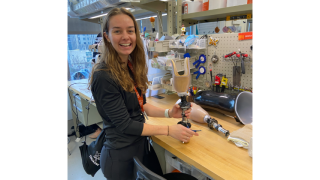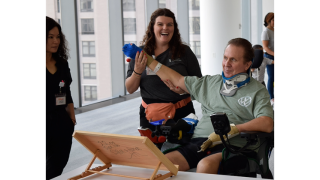Body
Problems with temperature regulation happen in people with cervical and high thoracic spinal cord injuries. Body temperature may change somewhat with the air temperature: if you are in a cold place, body temperature will drop; if you are in a very warm place, body temperature will rise. In a hot environment, the body normally sends a signal saying it is hot through the brain and spinal cord, and overheating is prevented by telling the body to cool down by sweating. In a cold environment, these signals keep you warm by causing the blood vessels to constrict and the body to shiver.
When you have a spinal cord injury, your body and brain may not send or receive these signals properly, causing the body to experience hyperthermia (too hot) or hypothermia (too cold). The normal responses to hot and cold, such as sweating or shivering, may still occur, but only above your level of injury. They are not as effective if the whole body does not react to them. You may not experience the feeling of hot and cold as you used to, but your body is still sensing and responding to it. It is important to be aware that your body can be more sensitive to changes in temperature and prepare accordingly. You should also pay attention to the other signals your body sends you about its temperature, not just sensation.
Prevention
• The most important thing is to avoid extreme temperatures.
• In hot weather, don't stay out too long, avoid direct sunlight, and drink plenty of fluids.
• In cold weather, wear layers of warm clothing. Make sure hands and feet are kept dry and well covered to avoid frostbite.
Signs and Symptoms
• In hot weather when body temperature rises, you may get a headache, feel dizzy or nauseated. Your face and neck may become red. Temperature may reach 100 degrees Fahrenheit or higher.
• In cold weather when body temperature falls, you may feel chilled and your teeth may chatter.
Treatment
• If body temperature is high, get out of the heat if at all possible. Go to an air conditioned room or use a fan. Take off layers of clothes. Sponge off with cool water. Drink plenty of cool fluids.
• If your body temperature is low, cover up with blankets. Go into a heated room or increase the heat by just a few degrees. Drink warm fluids or food.
• Avoid cold/ice packs and heat packs or electric heating pads/blankets. You may not sense the extreme temperatures of these packs and may experience frostbite or burns.
• Take breaks from hot or cold environments and allow your body to rest and regulate itself, in addition to the measures above.
If your temperature remains high or low despite the measures listed, it may be due to another reason, such as an infection. Contact your doctor.
Body
This content is for informational purposes only and may not be comprehensive. Information contained does not imply an endorsement from Shirley Ryan AbilityLab, and does not replace the advice of a qualified healthcare professional. See here for further details.© Shirley Ryan AbilityLab (formerly Rehabilitation Institute of Chicago). Henry B. Betts LIFE Center – (312) 238-5433 – https://www.sralab.org/lifecenter.



